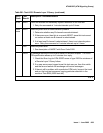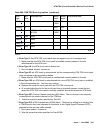
Communication Manager Maintenance-Object Repair Procedures
614 Maintenance Procedures for Avaya Communication Manager 3.0, Media Gateways and Servers
Notes:
a. Error Type 0: Run the short test sequence first. If every test passes, run the long test
sequence. Refer to each appropriate test’s description, and follow its recommended
procedures.
b. Error Type 1: problem with the primary DS1 reference. It is cleared when the primary
reference is restored. The following steps should give an indication of the source of the
problem:
1. Check if the primary DS1 interface circuit pack is inserted in the carrier with list
configuration board location.
2. Verify that the administered primary reference matches the DS1 reference from the
network synchronization plan.
3. Test the primary DS1 interface circuit pack with test board location long. Check
the Error Log for DS1-BD or UDS1-BD errors and see DS1-BD (DS1 Interface Circuit
Pack) on page 978 or UDS1-BD (UDS1 Interface Circuit Pack) on page 2374 to resolve
any errors associated with the primary DS1 (DS1 or UDS1) interface circuit pack. If the
only errors against DS1-BD or UDS1-BD are slip errors, then follow the procedures
described in the troubleshooting section above. If no errors are listed in the Error Log for
the primary DS1 interface circuit pack, continue with the following steps.
4. Test the active Tone-Clock circuit in the master PN with test tone-clock location long.
Check the Error Log for TDM-CLK errors and verify that TDM Bus Clock Test #148 (TDM
Bus Clock Circuit Status Inquiry test) passes successfully. If Test #148 fails with an Error
Code 2 through 32, see TDM-CLK (TDM Bus Clock)
on page 2252 to resolve the
problem.
c. Error Type 257: problem with the secondary DS1 reference. It is cleared when the
secondary reference is restored. Refer to note (a) to resolve this error substituting
secondary for primary in the preceding resolution steps.
d. Error Type 513: the ATM switch clock is inferred to be providing the timing source for the
system. The primary and secondary (if administered) are not providing a valid timing signal.
Investigate errors 1 and 257 to resolve this error.
e. Error Type 1537: over half of the DS1s that are administered with slip detection enabled
through the Slip Detection field set to y are experiencing slips. It may take up to 1 hour for
these alarms to clear via the “leaky bucket” strategy.
f. Error Type 1793: inferred excessive switching of system synchronization references has
occurred. When this error occurs, it is inferred that the ATM switch clock has become the
synchronization reference for the system. It may take up to 1 hour for these alarms to clear
via the “leaky bucket” strategy.
1. Check for timing loops and resolve any loops that exist.


















